summer02
Back to VCBS First Page
INSIDE THIS ISSUE:
LOCAL HISTORICAL SOCIETIES GATHER FOR EXPO 2002
JUNE 29TH POWER HOUSE BRIDGE OPENING CELEBRATION
FITCH'S COVERED BRIDGE REDEDICATION SET FOR JULY 20
REPAIRS BEGUN ON PULP MILL BRIDGE
THE VERMONT COVERED BRIDGE SOCIETY "PATCH" NOW AVAILABLE!
MUSEUM TO BE "PORTAL TO BRIDGES"
BRIDGE TALK - About Rehabilitation, Restoration, and Reconstruction of Covered Bridges
MY VERMONT COVERED BRIDGES THE PRESIDENT'S COLUMN
COVERED BRIDGE ITEMS FOR SALE
The 3rd VCBS All-member Meeting will be held June 15, 2002 in Stowe, Vt. at the celebrated Helen Day Art Center, hosted by Ed Rhodes, VCBS Chairman for the Stowe Bridge-watch Area. All are welcome to attend.
Attendees are invited to bring their covered bridge memorabilia for bragging, swap or sale. The displays can remain through the day until adjournment.
The meeting will begin at 10 a.m. at the art center with a social hour featuring coffee and displays of covered bridge memorabilia followed by an informal "Walk-about" historic Stowe Village. Maps of the village will be available.
At 11 a.m. VCBS Vice President and Structural Engineer John Weaver, P.E., will give a Bridge-watch presentation illustrated by a slide show of Vermont's covered bridges.
The meeting will break at noon when participants can lunch on their own at any of the several village restaurants within walking distance.
At 1 p.m. a brief business meeting will be held. The membership and treasurers report will be given and the proposed changes to the Society bylaws will be discussed and voted upon.
The business meeting will be followed by a tour of Stowe's covered bridges conducted by Ed Rhodes. A car pool will be formed in the Helen Day Center parking lot.
A chicken-and-biscuit dinner will be served at the art center by the Eastern Star with all the fixing's (and pie) for $8/plate at 5 p.m. Dick Roy, Historian for the National Society for the Preservation of Covered Bridges will speak and give his famous dual-projector slide presentation.
People wishing to attend the dinner are asked to contact Ed Rhodes, P.O. Box 822, Stowe, VT 05672-0822 or email: edatstowe@aol.com or phone: 802 253-6360.
VCBS To Exhibit at VHS Expo 2002 June 22 and 23!
The VCBS has a booth in Floral Hall at the Vermont Historical Society's Expo-2002 to be held at the Tunbridge Fairgrounds. The theme of our show is "The Changing World of Vermont's Covered Bridges." Don and Pauline Prideaux, Neil Daniels, John Dostal, John Weaver, Ed and Irene Barna, and Joe Nelson will be sitting with the display. Members are encouraged to attend this worthwhile Vermont Historical Society event. While you are there, drop by the VCBS booth and cheer on our sitters.
Power House Bridge, Johnson, Vt.
On June 22, beginning at 8 a.m., townspeople will have their turn to work on the new Power House Bridge. The ribbon cutting will be held June 29 at 10 a.m. See article in this issue.
The official opening of Fitch's Covered Bridge to be July 20, 2002. See article "Fitch's Covered Bridge Rededication Set" in this issue for details.
The North Troy SummerFest to be held August 10 and 11, 2002.
The North Troy SummerFest will be held again this year with a special invitation to all of the covered bridge societies. Bridgers are invited to bring their covered bridge displays and memorabilia to the show. Check out the SummerFest website for details: www.jaypeakvermont.org Return to Top
[VHS press release]
100 local historical societies from throughout Vermont will piece together the State's history with stories of their communities in mini-museum exhibits at Vermont History Expo 2002, June 22-23, at the Tunbridge World's Fair Grounds. This two-day tapestry of Vermont, presented by the Vermont Historical Society, commemorates and celebrates the depth of the State's rich heritage.
Again recognized by the State Chamber of Commerce as one of Vermont's Top Ten Summer Events, the History Expo is now in its 3rd year with the largest supporting cast ever.
The 2002 event will bring 101 year-old Sterling Weed of St. Albans, the nation's oldest band leader, to conduct his Weed's Imperial Orchestra, one of 24 musical performances planned for three entertainment stages. Sharing the Main Stage with Mr. Weed are the Vermont Youth Orchestra and the Saltash Serenaders.
On a second stage, Diane Zeigler joins other performers including Peter Mallary, and his traditional country music trio - Mallary, Emerson, and Gale.
In the Historical Presentation Tent, visitors will be entertained by, among others, the "Sweet Memories" of Wilson Bill Clark, who served the Vermont's Maple Sugar Association for 40 years. Colonial Williamsburg in Virginia and the Jefferson Legacy Foundation in Ripton will send Bill Barker, a first-person interpreter of Thomas Jefferson, to relate the former President's visit to Vermont.
Attendees will meet 10 authors who have written about Vermont, and to discuss their work with them. Among this year's guests are Katherine Patterson, children's book author who received the 2001 Governor's Award for Excellence in the Arts, and Laurel Thatcher Ulrich, who talks about her new book, "The Age of Homespun."
No less popular with visitors of all ages is the collection of heirloom and rare breed animals housed in the fair's stables.
For those who are interested in the hobby of researching family histories, the Vermont History Expo offers a Genealogy Resource Center, with on-line computers and staffed by representatives from 12 of the State's leading genealogy organizations.
Demonstrations ranging from grain-braiding, to wood-carving, to making traditional wood frame snowshoes will be on-going in the Craft Tent where 25 of Vermont's talented craft people will set up shop for the weekend.
Young historians can try their hand at crafting heritage-related items in workshops on making 19th century toys. They can also wander over to the Bicknell Hill District #8 Schoolhouse to hear about the children who played with those toys from the presiding School Master.
The Revolutionary and Civil War encampments on the grounds provide more living history for visitors who can learn what life was like for Vermonters during past wars by talking to the "soldiers" themselves.
Taken collectively, the reenactors and crafts people, historians and musicians, genealogists and performers of the Vermont History Expo are telling the State's stories - highlighting the unique and rich heritage that makes Vermont a special place to live, work, and visit.
Vermont History Expo 2002 runs from 10:00 a.m. - 5:00 p.m., Saturday and Sunday. Daily admission fees are: Adults, $7.00; Children/Students (6-18 years), $4.00; Children 5 years and under, Free; 20% discount for groups of 20 or more.
Return to Top
by Eric T. Osgood, Selectboard Chair.
 |
Coming along nicely, thank you! Photo by Joe Nelson, May 28, 2002 |
Main Street Stage: Mutt & Jeff- local jazz, bluegrass duet; Spencer Lewis and the Power Duo- fiddle duet; Davy Jones- folk musician from California, writing a song about the bridge; Natterjack- Irish traditional and rock (after festival in front of Ryan Books).
School Street Stage: Mark Struhsacker and Tony Washburn- two members of Radio Rangers; Vermont Dance Collective- traditional, period dancing; Tammy Fletcher- need we say more; The Parsnips- fiddle group that will hopefully lead to some dancing.
Heidi Soos, a harpist, will perform as part of the ceremony and possibly again later. Steven Wringle, a clown from New York, will also be involved.
Other attractions: Pony rides; Hay rides(not guaranteed); Boom truck rides with Ken Phelps; Field games sponsored by the PTA; Skateboarding demonstration by Skateboard Park Group; Art table sponsored by the Vermont Studio Center.
This will be a FUN DAY FOR ALL AGES! Return to Top
from Michele DeFreece
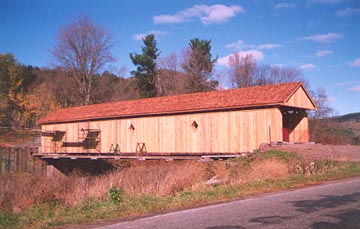 |
The ceremony begins at l0 a.m. and will be held at the bridge. The bridge will be closed to traffic from 8 a.m. to 12 noon this day. Special guest speakers will be Irma Petras, Vice President of the New York Covered Bridge Society, Phil Pierce, Deputy Commissioner, Delaware County DPW, James Stewart, Bernice Stewart's son as well as representatives from NY Senator Bonacic's and Assemblyman Crouch's offices.
The program will end with a short parade to the Delaware County Historical Association on Route 10 for a reception. Highlights include music by "Touch of the Catskills," light refreshments, a display of Delaware County Covered Bridges and experts to answer questions about the history of Fitch's Covered Bridge.
Parking will be available on County Route 18 across from the bridge. The Steven Kamvakis Family has kindly agreed to make their land available for parking during this historic event.
We hope you will then join the Village of Delhi on Main St for Delhi Community Days. The American Legion will be having food vendors and activities at their site also. Return to Top
MIDDLEBURY- Repairs to the covered bridge connecting the towns of Middlebury and Weybridge across Otter Creek were slated to begin April 27.
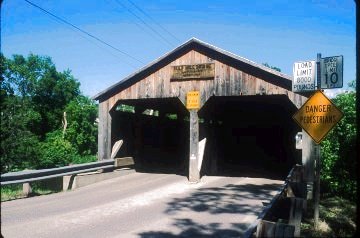 |
Photo by Joe Nelson, June 1995 |
According to covered bridge historian Herbert Wheaton Congdon, the Pulp Mill Bridge was built for the Waltham Turnpike Company in 1820. It is the one of the last two of Vermont's "double-barrel," or two-lane covered bridges. The other was built at Cambridge Vermont in 1845 and moved in 1951 to the Shelburne Museum where it serves as an entrance for staff.
Other covered bridges slated for major repairs are the Sanderson Bridge in Brandon, Built c. 1838, and the Greenbanks Hollow Bridge, 1889, in Danville. The work proposed for the Brandon bridge was advertised by the state for bids on or about May 27. Bids for the Danville bridge will be opened soon. Return to Top
A long time on the "wish list," the new patch is finally a reality. The design was donated by Francis Converse way back before the first VCBS Annual Meeting held November 11, 2000. The design was ultimately digitized in color and sent out to three manufacturers for cost
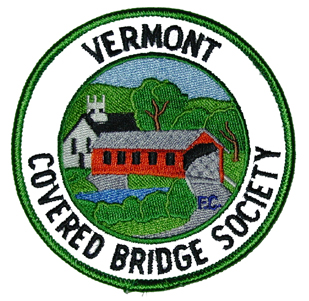 |
When email and letters were received from members of other covered bridge societies asking for a VCBS patch, we were encouraged that perhaps the project was viable. A member has stepped forward with the needed funding.
The patches are now on sale through the web site; www.vermontbridges.com/market.place.htm and will be available at all VCBS meetings for $3.50. The profits will go to the VCBS to provide revenue to help fund the VCBS mission advocating the preservation of covered bridges.
The new patch depicts the "Bridge-at-the-Green" in West Arlington, Vermont, the covered bridge and chapel familiar to us all, it being one of the most photographed of the state's scenic places. The initials "F.C." honor designer Francis Converse. Return to Top
by Vanessa Wassenar
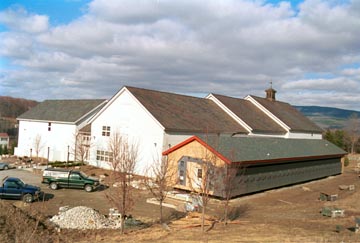 |
Photo by Joe Nelson - 3-12-02 |
Return to Top
[The purpose of the Vermont Covered Bridge Society is to advance the preservation of our covered bridges. The purpose of the "Bridge Talk" series of presentations is to educate our readership in the problems encountered in the actual work of preservation. These presentations do not necessarily reflect the preservation policy of the VCBS. Readers are invited to critique the articles. Send your viewpoint to the Bridger editor. The address is in the staff block. - Editor]
by Phil Pierce, P.E.
There is a lot of controversy about the terminology related to work on covered bridges. I have copied a portion of the text out of a web site from the Advisory Council on Historic Preservation (ACHP). It is included below. You will find that it offers many opportunities for individual interpretation. I am trying to condense it into something to add to my Manual . As a very brief summary, my interpretation of the three main terms: rehabilitation, restoration and reconstruction is as follows:
Rehabilitation - a form of attempting to preserve as much as possible, while being willing to make alterations to accomplish a desired goal - e.g. - to keep a covered bridge open to traffic, one will have to accept more modifications than one would have to if the bridge was not to be open to traffic.
Restoration - a form of preservation aimed at maintaining a functioning structure if possible, but it allows some strengthening, preferably hidden, as in that done on the Capitol Dome or at Monticello. It's pretty hard to hide strengthening in a CB project, although efforts are made to do so at times.
Reconstruction - the most restrictive form of preservation, and more aimed at preserving the original fabric or examples of construction details, even if that means losing the functionality of the structure (e.g. maintaining some features of a CB may force acceptance of a non-standard capacity such that the structure could not be deemed safe for traffic).
It is my firm conviction, that if we are to keep bridges open to traffic (and I think most of us wish to), then we cannot accomplish that following the strict requirements of a "reconstruction" project. Even "restoration" involves many actions not compatible with the work normally envisioned for CB projects. Hence, in my opinion, virtually all work with which I am familiar fits the category of rehabilitation projects and not restoration and certainly not reconstruction projects. All projects for the VAOT that I have been involved with has insisted on careful use of these terms to abide by the guidelines from FHWA. I am unaware of any engineer or owner who claims to have fulfilled work on an extant CB to maintain its use for larger vehicular traffic while meeting all of the stringent criteria of either restoration or reconstruction. Having said that, I suspect that there are those who will claim to have done so - we all would benefit from more education about this topic.
The following was copied directly from the ACHP website, under the heading of 106 and the Secretary's Standards for Historic Preservation (http://www.achp.gov/secstnd.html#SHPP):
General Standards for Historic Preservation Projects
The following general standards apply to all treatments undertaken on historic properties listed in the National Register.
1. Every reasonable effort shall be made to provide a compatible use for a property that requires minimal alteration of the building, structure, or site and its environment, or to use a property for its originally intended purpose.
2. The distinguishing original qualities or character of a building, structure, or site and its environment shall not be destroyed. The removal or alteration of any historic material or distinctive architectural features should be avoided when possible.
3. All buildings, structures, and sites shall be recognized as products of their own time. Alterations which have no historical basis and which seek to create an earlier appearance shall be discouraged.
4. Changes which have taken place in the course of time are evidence of the history and development of a building, structure, or site and its environment. These changes may have acquired significance in their own right, and this significance shall be recognized and respected.
5. Distinctive architectural features or examples of skilled craftsmanship which characterize a building, structure, or site shall be treated with sensitivity.
6. Deteriorated architectural features shall be repaired rather than replaced, wherever possible. In the event replacement is necessary, the new material should match the material being replaced in composition, design, color, texture, and other visual qualities. Repair or replacement of missing architectural features should be based on accurate duplications of features, substantiated by historic, physical, or pictorial evidence rather than on conjectural designs or the availability of different architectural elements from other buildings or structures.
7. The surface cleaning of structures shall be undertaken with the gentlest means possible. Sandblasting and other cleaning methods that will damage the historic building materials shall not be undertaken.
8. Every reasonable effort shall be made to protect and preserve archeological resources affected by, or adjacent to, any acquisition, stabilization, preservation, rehabilitation, restoration, or reconstruction project.
Specific Standards for Historic Preservation Projects
The following specific standards for each treatment are to be used in conjunction with the eight
general standards and, in each case, begin with No. 9. For example, in evaluating acquisition
projects, include the eight general standards plus the four specific standards listed under Standards
for Acquisition. The specific standards differ from those published for use in Historic Preservation
Fund grant-in-aid projects (36 CFR Part 68) in that they discuss more fully the treatment of
archeological properties.
Standards for Acquisition
9. Careful consideration shall be given to the type and extent of property rights which are required
to assure the preservation of the historic resource. The preservation objectives shall determine the
exact property rights to be acquired.
10. Properties shall be acquired in fee simple when absolute ownership is required to insure their
preservation.
11. The purchase of less-than-fee simple interests, such as open space or facade easements, shall
be undertaken when a limited interest achieves the preservation objective.
12 Every reasonable effort shall be made to acquire sufficient property with the historic resource
to protect its historical, archeological, architectural or cultural significance.
Standards for Protection
9. Before applying protective measures which are generally of a temporary nature and imply
future historic preservation work, an analysis of the actual or anticipated threats to the property
shall be made.
10. Protection shall safeguard the physical condition or environment of a property or
archeological site from further deterioration or damage caused by weather or other natural, animal
or human intrusions.
11. If any historic material or architectural features are removed, they shall be properly recorded
and, if possible, stored for future study or reuse.
Standards for Stabilization
9. Stabilization shall reestablish the structural stability of a property through the reinforcement of
load-bearing members or by arresting deterioration leading to structural failure. Stabilization shall
also reestablish weather resistant conditions for a property.
10. Stabilization shall be accomplished in such a manner that it detracts as little as possible from
the property's appearance and significance. When reinforcement is required to reestablish
structural stability, such work shall be concealed wherever possible so as not to intrude upon or
detract from the aesthetic and historical or archeological quality of the property, except where
concealment would result in the alteration or destruction of historically or archaeologically
significant material or spaces. Accurate documentation of stabilization procedures shall be kept
and made available for future needs.
11. Stabilization work that will result in ground disturbance shall be preceded by sufficient
archeological investigation to determine whether significant subsurface features or artifacts will be
affected. Recovery, curation and documentation of archeological features and specimens shall be
undertaken in accordance with appropriate professional methods and techniques.
Standards for Preservation
9. Preservation shall maintain the existing form, integrity, and materials of a building, structure, or
site. Archeological sites shall be preserved undisturbed whenever feasible and practical Substantial
reconstruction or restoration of lost features generally are not included in a preservation
undertaking.
10. Preservation shall include techniques of arresting or retarding the deterioration of a property
through a program of ongoing maintenance.
11. Use of destructive techniques, such as archeological excavation, shall be limited to providing
sufficient information for research, interpretation and management needs.
Standards for Rehabilitation
9. Contemporary design for alterations and additions to existing properties shall not be
discouraged when such alterations and additions do not destroy significant historic, architectural
or cultural material and such design is compatible with the size, scale, color, material and
character of the property, neighborhood, or environment.
10. Wherever possible, new additions or alterations to structures shall be done in such a manner
that if such additions or alterations were to be removed in the future, the essential form and
integrity of the structure would be unimpaired.
Standards for Restoration
9. Every reasonable effort shall be made to use a property for its originally intended purpose or to
provide a compatible use that will require minimum alteration to the property and its environment.
10. Reinforcement required for structural stability or the installation of protective or code
required mechanical systems shall be concealed wherever possible so as not to intrude or detract
from the property's aesthetic and historical qualities, except where concealment would result in
the alteration or destruction of historically significant materials or spaces.
11. Restoration work such as the demolition of non-contributing additions that will result in
ground or structural disturbance shall be preceded by sufficient archeological investigation to
determine whether significant subsurface or structural features or artifacts will be affected.
Recovery, curation and documentation of archeological features and specimens shall be
undertaken in accordance with appropriate professional methods and techniques.
Standards for Reconstruction
9. Reconstruction of a part or all of a property shall be undertaken only when such work is
essential to reproduce a significant missing feature in a historic district or scene, and when a
contemporary design solution is not acceptable. Reconstruction of archeological sites generally is
not appropriate.
10. Reconstruction of all or a part of a historic property shall be appropriate when the
reconstruction is essential for understanding and interpreting the value of a historic district, or
when no other building, structure, object, or landscape feature with the same associative value has
survived and sufficient historical or archeological documentation exists to insure an accurate
reproduction of the original.
11. The reproduction of missing elements accomplished with new materials shall duplicate the
composition, design, color, texture, and other visual qualities of the missing element.
Reconstruction of missing architectural or archeological features shall be based upon accurate
duplication of original features substantiated by physical or documentary evidence rather than
upon conjectural designs or the availability of different architectural features from other
buildings.
12. Reconstruction of a building or structure on an original site shall be preceded by a thorough
archeological investigation to locate and identify all subsurface features and artifacts. Recovery,
curation and documentation of archeological features and specimens shall be undertaken in
accordance with professional methods and techniques.
13. Reconstruction shall include measures to preserve any remaining original fabric, including
foundations, subsurface, and ancillary elements. The reconstruction of missing elements and
features shall be done in such a manner that the essential form and integrity of the original
surviving features are unimpaired.
Return to Top
by Conrad M. Nagengast
My wife and I decided in 1977 that we should take a trip through the northeastern states. I had been to Boston and Portland, Maine when I was in the Navy in 1942. We, Dale and I, flew from Chula Vista, California to Boston and rented an auto to make our tour of the New England states. After leaving Boston our trip took us through Maine, New Hampshire and into the Green Mountain State. Driving down along the Connecticut River, we stopped for a "pit stop". In looking over the fence and down I saw a WOODEN COVERED BRIDGE! That was probably the exact moment the love and interest for these wonderful relics of the past commenced for me.
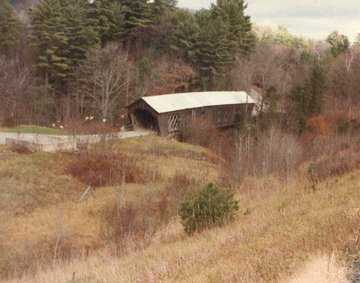 |
I was born in Albion, Erie County, Pennsylvania. Albion is about 128 miles from Buffalo, New York. Albion is about four miles from Sherman (38-25-02), 4 1 /2 miles from Carmen (38- 25-05), eight miles from Gudgeonville (38-25-03) and 18 1 /4 miles from Waterford (38-25-04). Pennside (38-25-01) was still there about 6 miles from Albion when I was a lad. These distances are just estimated. I did not give accurate distances since, hopefully, you will have a World Guide to accomplish that information. Today's maps are of better use than the maps of 1977. The roads, highways and even streets have changed and updated since 1977.
The ADC Map people publish an excellent Pennsylvania State Road Atlas. DeLorme also puts out a fine Atlas/Gazette. For the people new to the covered bridge world, one should carry with you the following: The latest maps of the area (auto clubs will furnish); a small note-book to record the camera views; a compass (to be able to record the directions such as N portal, E side, SW corner, etc., camera needs; extra film, batteries, comfortable clothing to suit the weather with a complete change in case of dampness; and a pad to take additional notes (road and/or bridge closed or on private land).
And now back to Vermont. Dale and I returned to the Green Mountain State in May of 1984 and again in October of 1987. I have visited and taken photos of every authentic bridge in Vermont with the following exceptions: Station Bridge (45-01-01), always flooded with the road blocked off; Garfield Village Bridge (45-08-05), moved in 1973 to Windsor County, split in half and made into 45-14-17 and 45-14-18; Flint (45-09-11), the road blocked off and we were unable to approach the bridge; and Mead (45-11-08), "arsoned" 7/22/71.
I have not given notice to the little bridges known as "Romantic Shelters." I have taken photos of many of these small bridges in my travels but consider that as being not concerned with the preservation of the great marvels of time and the ingenuity of their builders.
[Editor's note: Author Nagengast provided many photographs to accompany his article, however, because of space limits they are not presented here. To see "Connie's" article with selected photos in color go to INDEX → COVERED BRIDGE NEWS → MY VERMONT COVERED BRIDGES] Return to Top
What with our upcoming Third All-member Meeting on June 15 and checking out our "Mark Your Calendar" column I see we have a fairly busy summer coming up.
When member Ed Rhodes was asked if he would host our All-member meeting, he responded with enthusiasm. He has arranged for our use, for the whole day, a large room on the second floor of the Helen Day Art Center Building. There is space in which to lay out our covered bridge stuff, a handy parking lot in back, lots of restaurants near by for lunch, an historic village to explore, and in the adjoining rooms, first rate art exhibits. What more could one ask for? A chicken with biscuits supper, of course, served in the big room by the ladies of the Eastern Star. When you meet Ed, be sure to shake his hand and thank him.
We will have our usual tour of the local covered bridges, and a business meeting, hopefully a short one. We will be discussing and voting on the proposed changes to our bylaws (which would give more membership options and make it easier to schedule our Annual Meeting) and our membership report (about a third of our membership has not yet renewed).
Please check the mailing label on this issue of the Bridger. If it has a notation that looks like this: (01), it means that the membership expired last December. In a few weeks those members who haven't paid their dues will receive a personal letter of reminder from the Membership Committee. If they don't respond, we must assume that they have lost interest in the objectives of the VCBS and they will have received their last Bridger Newsletter you see, one of our largest annual expenditures is for postage and with our limited resources we can't afford to continue to send our message to those who no longer support us.
Yours in Bridging: Joe Nelson

|
|
The American Covered Bridge Collection A portion of the sales of this high quality reproduction of America's Covered Bridges is donated to the National Society for the Preservation of Covered Bridges (NSPCB). These fabulously detailed replicas of Covered Bridges bring back to life the beauty and grace of early American architecture. The stunning detail, inside and out, will make you wish you were there when horse and buggies were the only form of transportation available. There are 23 bridges in the Series I collection. Their popularity has Scaasis adding more bridges to the collection already. Each Covered Bridge in the collection includes a gold information certificate located on the base. Here you will find pertinent details about the bridge such as when it was built, who built it, its span and truss type. These Limited Edition gift items are featured in quality gift shops nationwide like these. Or call Scaasis directly at the number listed below for a list of retailers in your area. |
|
Sea Shell Shop Rehobeth Beach, DE (302) 227-6666 Cypress Clocks of Florida Astor, FL (352) 759-3980 Lighthouse Keepers Closet Bradenton, FL (941) 753-3028 Stone Mountain Park Branson, GA (417) 338-2611 A Little Bit of Christmas Marietta, GA (770) 643-8792 True Grits Savannah, GA (912) 234-8006 Sammi Kay's Gifts Davenport, IA (563) 3223-0059 |
Amish Acres Nappanee, IN (219) 773-4188 International Gift House Fallston, MD (410) 877-3113 Whitesell Pharmacy Lusby, MD (410) 326-2004 Country By The Bay Ocean City, MD (410) 213-1547 Marty's Playland Ocean City, MD (410) 289-7271 Clark's Hallmark Shops Ledgewood, NJ (973) 584-5119 Goodies Galore Marysville, OH (937) 644-0251 |
Country Home Candle Shop Brodheadsville, PA (570) 992-5000 Zachary's Camp Hill, PA (717) 737-6999 Fifth Avenue Cards Lancaster, PA (717) 392-8731 Miller's Country Store Ronks, PA (717) 392-8731 Heart `N' Home Fredericksburg VA (540) 785-4095 Scaasis Originals, Inc. Neptune, NJ (800) 942-2139 |
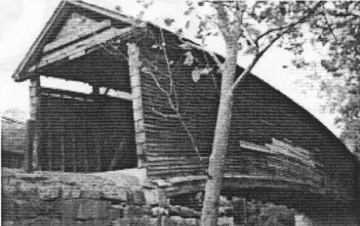 |
|
A new book by Leola B. Pierce Documenting the lives and histories surrounding nine historic covered bridges in the state of Virginia. Includes technical descriptions, fascinating photographs, family and historical background material and commentary from a professional transportation engineer. Available now from Upstream Press 877-401-9500 or www.upstreamnress.com |
| (800) (2) (11) (100) (3) 14 (1) (1) | 3by5 modern covered bridges all in USA 3by5 Somerset County, PA long-gone of PA 4by6 PA 4by6 of Ontario Canada views of PA 4by6 5by7 of Breezewood, Bedford County, PA 5by7 of Cornwall, CT The postcard list |
$0.10 each $0.30 each $0.50 each $0.25 each $0.50 each $0.35 each $0.59 each $0.35 each $6.41 each |
| Plus postage and handling. No stamps accepted as payment please. Make check or money order payable to Robert L. Damery, 2000 Burma Road, New Smyrna Beach, FL 32168- 8302 |
 Joe Nelson, P.O Box 267, Jericho, VT 05465-0267, jcnelson@together.net
Joe Nelson, P.O Box 267, Jericho, VT 05465-0267, jcnelson@together.netNo part of this web site may be reproduced without the written permission of Joseph C.
Nelson
This file posted June 5, 2002